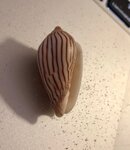- Messages
- 16,644
- Reaction score
- 5,417
- # of dives
- 1000 - 2499
Yeah. Lots of old threads on this (since I joined in 2007), so no need to rehash it all here.TMHeimer collects live shells. He is a collector. He may not be the most popular diver on ScubaBoard because of this, but he is pretty thick skinned about it.
In keeping with the thread, to my knowledge, not that many cone shells are venomous. As I mentioned, Textile Cones. Also some of the exotic ones, like the once rarest shell in the world Glory-of-the Seas Cone. It was worth $1,200US in the '70s (70 known specimens) until a fisherman hauled up about 100 more of them in the Indo-Pacific. Now it's just "uncommon".
In googling cones, I was wrong. Apparently all are venomous to some degree. Smaller ones' amount to a bee sting. Larger ones can be fatal. But I'm not a conchologist.





